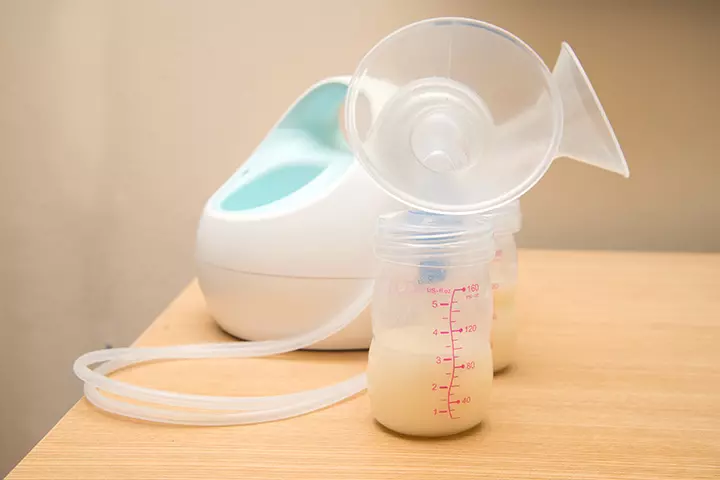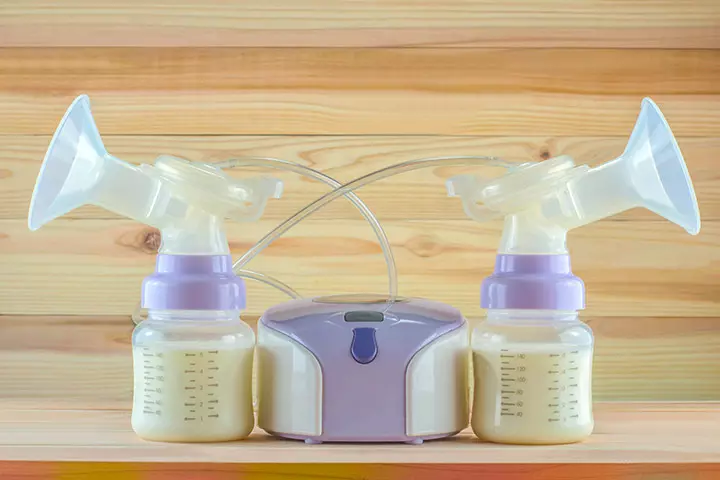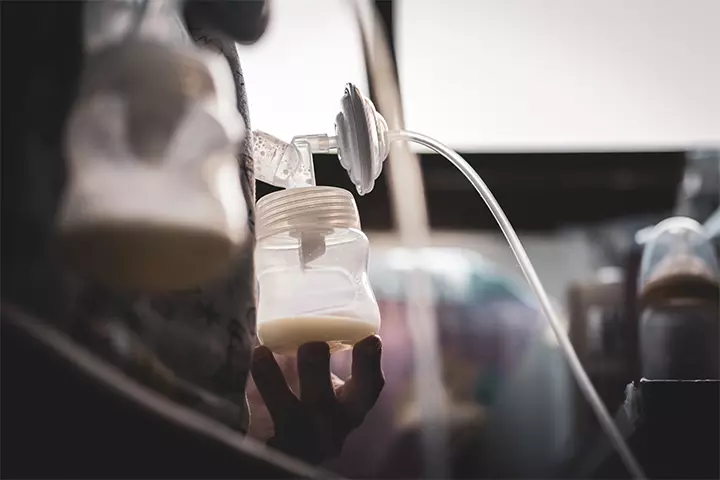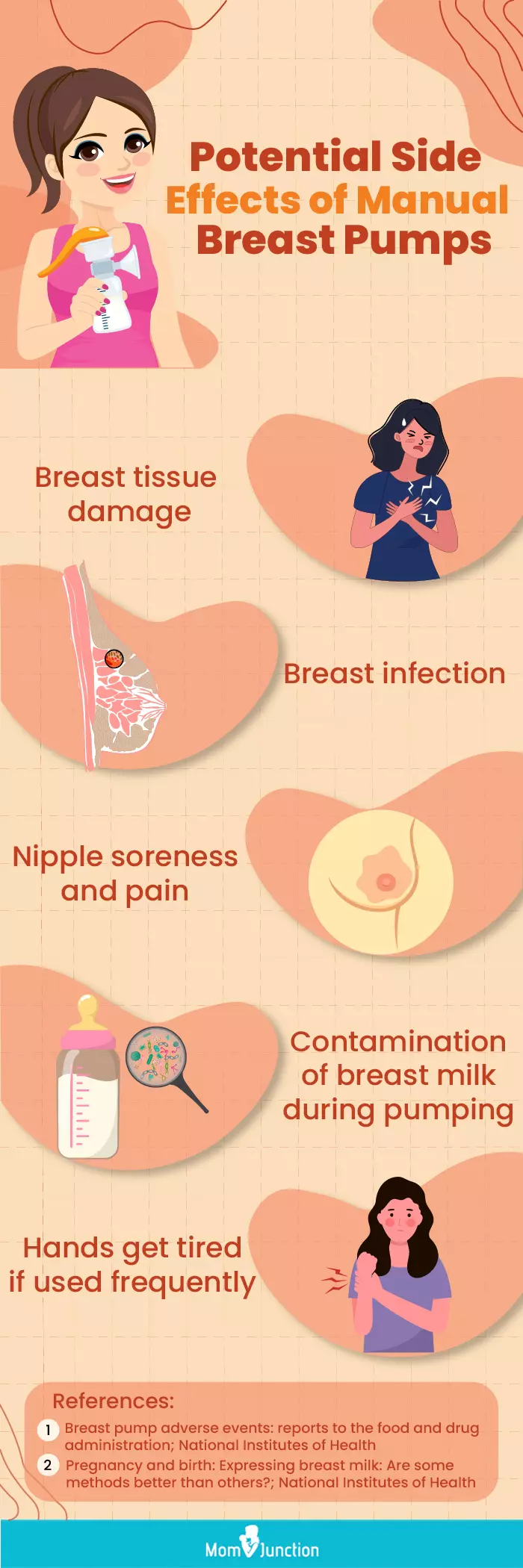
Image: Shutterstock
Breast pumps help lactating women extract milk from their breasts and store it for future use. A manual breast pump helps mothers provide their babies with precious breast milk loaded with antibodies to boost their immunity even when they are not around. This device functions on hand movements and its pumping efficiency for extracting breast milk is great. In this post, we present you with the types, different parts, points to consider before buying, and tips on using a manual breast pump.
Key Pointers
- Breast pumps extract and store breast milk for future use, ensuring the baby can be fed nutritious milk even when the mother is not around.
- A breast pump is needed if the baby can’t feed directly, is premature, has latch issues, if the mother is returning to work, or has plugged ducts and engorgement.
- There are three types of breast pumps available in the market: manual, battery-powered, and electric.
- A manual breast pump typically consists of a breast shield/flange that fits over the nipple, a pump that extracts milk, and a container that collects and stores milk.
- It is essential to seek advice from a certified lactation consultant before using breast pumps and storing milk.
What Is A Breast Pump?
Breast pumps are devices designed to extract (express) breast milk from a mother’s breasts and supplement or replace breastfeeding via bottle or alternative feeding method. Some pumps even mimic the suckling action of a baby.
Why Do You Need A Breast Pump?
As a new mother, you might need a breast pump for several reasons. A few of them are:
- The baby is not able to breastfeed directly or has medical complications.
- The baby is born premature or cannot latch on to the breast. These babies need breastfeeding support.
- You have to return to work or study and do not have the chance to breastfeed several times in a day.
- You are unable to sit for long to breastfeed the baby.
- You need to relieve clogged milk ducts or pull out a flat or inverted nipple.
- Get relief from the pain and pressure of engorged breasts, especially where the baby is unable to provide that relief.
There are different types of breast pumps. They help overcome various breastfeeding challenges.
What Are The Types Of Breast Pumps?
There are three basic types of breast pumps:
1. Manual breast pumps
Manual breast pumps usually have a lever or handle, which needs to be operated manually in order to express the breast milk. The milk is then collected in a container.
These breastfeeding accessories are usually small and handy and can be great to use on the go. Some of the disadvantages are being unable to express both breasts at the same time and the chance that your hands may hurt from constant manual effort required to work the pump.
2. Battery-powered breast pumps

A battery powered pump uses batteries to power a small motor that creates suction to express the breast milk. The powered pump can also control the degree of suction, hence varying the amount of milk collected. Depending on the model, battery-powered pumps may provide less suction than an electric pump with a power cord. Learning hands-on pumping can help in more milk expression and so, is good for infant nutrition.
3. Electric breast pumps

An electric pump is similar to a battery powered pump except that it has a cord that plugs into an electrical outlet.
Breast pumps can also be classified based on the pumping type:
- Single pumping
Single pumping type devices can be used to express milk from only one breast at a time.
Manual and most battery-powered pumps are single-pumping types.
- Double pumping:
Double pumping type devices are designed to express milk from both breasts simultaneously. These consist of two breast shields (also called flanges) with tubing connecting to the container. Most electric breast pumps are double pumping-type devices.
Though all types of breast pumps might suit, we will be focusing on manual breast pumps in this post.
 Point to consider
Point to considerWhat Are The Parts Of A Manual Breast Pump?
Any basic manual breast pump consists of the following parts:
- Breast shield/flange: A cone-shaped cup meant for fitting over the nipple and the areola.
- Pump: The component that creates a vacuum to express or extract the milk from the nipple. The pump can either be directly attached to the breast shield or through a plastic tube.
- Container: Collects the extracted milk. It can be either a bottle or a bag.
What Should You Look For When Buying A Manual Breast Pump?
You can rely on this checklist while buying a manual breast pump.
1. Usage of the pump
- How many times you will be using the pump
- If you want to use the pump in addition to breastfeeding or substitute direct breastfeeding
- How much milk you can pump in one session
2. Duration of each pumping session

- If you do not have time constraints, then using a manual pump may be a good option for you.
- If you plan to use the pump at work or do not have much time, look for a double electric or battery pump that extracts milk from both breasts, simultaneously.
3. The instructions on the manual pump
You need to understand the instructions to assemble, use, and clean the device. Review the instruction manuals of various pumps online or at the store to check their user-friendliness.
4. Place of use
Buy a smaller one if you intend to use it at your workplace. You can also consider exploring breast pumps that allow hands-free pumping. They can be used while working or driving. Researchers from the College of Saint Benedict and the Mayo Clinic conducted a cross-sectional survey on female physicians and trainees to understand the effect of using wearable, wireless breast pumps in the workplace. The findings highlighted that 59% of 542 respondents used a wearable pump in the workplace and reported shorter lactation breaks than those using traditional breast pumps.
5. Portability
If you intend to carry the breast pump while traveling, look for ones that are portable, do not take up a lot of space, and are easy to assemble and handle. Manual and battery pumps are easier to carry than electric ones and facilitate on-the-go pumping.
6. Breast shields of the pump
Make sure the breast shields match your breast size. Check the manufacturer’s website for the breast shield sizes and pick the one that fits you. It is important to know, pumping should not hurt. Many times, when pumping hurts, it’s because the shield/flange is too large. Only the nipple should be pulled into the funnel of the shield, not the areola.
7. The suction of the pumps
The amount of suction of the breast pump should be just right for your milk supply. Applying excessive suction power can leave you with sore and painful breasts after each pumping session and less suction will end up in engorged breasts even after a session. Begin at the lowest setting and increase based on your comfort level.
8. Design of the pump
You will want to look for a manual pump that is easy to hold and handle. Pumps with bulky designs can be difficult to use and transport.
 Caution
CautionHow To Use A Manual Breast Pump?
Here is how you can use a manual breast pump. You may also follow the instructions given on the product label.
- Start by massaging the breasts (lactation massage).
- Place the breast shield on your nipple. Your nipple should easily go inside the breast shield.

- Hold the breast shield in place with one hand and hold the lever/handle with the other hand.
- Wipe off any nipple cream or ointment before using a pump. This may not always be necessary, i.e. lanolin can act as a lubricant during pumping and also doesn’t need to be washed off before breastfeeding. Other creams or fragranced lotions may need to be wiped off.
- Move around the handle of the pump until you find an appropriate suction level. This will make the pumping easier.
- Keep yourself calm and be relaxed during the pumping session. Even consider looking at a picture or video of your baby. Time your session well so that you don’t have to rush through it.
- Gently insert your finger between your breast and the shield to break the vacuum seal and remove the shield from your breast.
- Shorter, more frequent pumping sessions are recommended over longer, infrequent sessions. This will help maintain your milk supply. Wash all the breast pump parts including the milk container, valves, and breast shields, after each use.
Note: Every manual breast pump is accompanied by a detailed instruction manual on how to use the pump. Follow the manual because detailed instructions change from pump to pump.
 Point to consider
Point to considerUse any leftover milk within two hours of your baby’s feeding, or immediately refrigerate it for proper storage to use for the next feeding.
How To Store Breast Milk After Pumping
It is of utmost importance to store expressed breast milk correctly. Freshly expressed milk can be left at room temperature (up to 77°F or 25°C) for four hours, but it’s best to refrigerate it as soon as possible. Breast milk should be divided into small batches of two to four ounces to ensure proper storage and minimize wastage. Refrigerate breast milk at 39°F (4°C) in the back of the refrigerator. While refrigerated breast milk can be safely stored for up to eight days, it is recommended to consume it within four days. If you don’t plan to use the breast milk within 24 hours, you can opt to freeze it. However, ensure not to fill the milk to the top of the container, as it will expand during freezing. Milk stored in a deep freezer at −4°F or −20°C can be frozen for about 12 months. You can thaw the frozen breast milk and use it within 24 hours of thawing. This careful storage method ensures that the milk’s quality remains intact for your baby’s nutrition (1).
General Tips On Using A Manual Breast Pump
Follow these tips when you are using a manual breast pump.
- Read through the entire instruction manual even if you have used a breast pump before.
- Wash your hands with soap and water and dry them thoroughly before using the pump.
- Wash your breasts before pumping, if you have been using any cream or ointment on them.
- Find a clean and comfortable place where you are not likely to be disturbed.
- Keep yourself calm and be relaxed during the pumping session. Time your session well so that you don’t have to rush through it.
- Pump as long as it feels comfortable and productive to you.
- Wash all the breast pump parts–container and breast shields, after each use.

How To Clean A Manual Breast Pump?
Follow these steps to clean your manual breast pump (7).
- Begin by washing your hands thoroughly and disassembling all pump parts.
- Clean the components in hot, soapy water using a dedicated wash basin, carefully scrubbing each piece with a clean brush designated for infant feeding equipment.
- Rinse thoroughly under running water or in a separate clean basin.
- Air-dry the parts on a clean, unused paper towel in a dust-free area and ensure no moisture remains.
- For extra protection, sanitize the pump parts daily using steam, boiling water, or a dishwasher with a sanitizing cycle.
- Always follow the manufacturer’s specific cleaning instructions and store clean, dry parts in a sealed, clean container.
Frequently Asked Questions
1. How long should I manually pump each breast?
While using a manual expression device, you may pump for about 15 minutes every three to four hours. If you are planning to go back to work, you may speak with your employer about an appropriate private space to pump and ensure to start practicing pumping two weeks before you start working (2).
2. Is a manual or automatic breast pump better?
Both pumps have their share of advantages and disadvantages. A manual pump is great for carrying anywhere but requires labor and time, while an electric pump is time-saving (3). Nonetheless, a research study says that a manual pump is as productive as an electric pump (4).
3. Should I pump after every feeding?
Yes, experts suggest you pump after every feed for at least ten minutes to maintain your milk supply and prevent breast discomfort (5).
4. How can I choose the correct manual breast pump for my needs?
When choosing a manual breast pump, opt for a trusted brand with positive reviews to ensure reliability and good customer support. Look for comfort features like soft silicone flanges or adjustable suction levels, and prioritize portability if you’ll need to pump on the go. Additionally, choose a pump that is easy to clean, with fewer parts or dishwasher-safe components.
Manual breast pumps allow the mother to control the pumping and its pace directly. They help express breast milk when breastfeeding is not possible due to illnesses or other issues. Also, babies who cannot latch or feed on breasts can be fed easily. The pumps are useful to collect and store breast milk for later use. Always follow advice from a certified lactation consultant to know the right ways to use breast pumps and store milk. You should also carry out breast pump cleaning as per recommended hygiene standards.
Infographic: Are There Any Side Effects Of Manual Breast Pumps?
Some women may experience a few side effects while using a manual breast pump. They may often try alternatives such as an electric breast pump or express with their hands. Go through the infographic to learn more about the side effects of manual breast pumps. Illustration: Momjunction Design Team
Illustration: Why And How To Use A Manual Breast Pump

Image: Dalle E/MomJunction Design Team
References:
- Tips for Freezing & Refrigerating Breast Milk.
https://www.healthychildren.org/English/ages-stages/baby/breastfeeding/Pages/Storing-and-Preparing-Expressed-Breast-Milk.aspx#:~:text=Freshly%20expressed%20milk%20can%20remain,F%20or%204%C2%B0C - Using A Breast Pump.
https://www.marchofdimes.org/find-support/topics/parenthood/using-breast-pump - 5 things to know about buying and using breast pumps
https://utswmed.org/medblog/breast-pumps/ - Donald K Hayes et al. (2008); Comparison of manual and electric breast pumps among WIC women returning to work or school in Hawaii
https://pubmed.ncbi.nlm.nih.gov/18333763/ - Breast-Feeding Questions
https://www.seattlechildrens.org/conditions/a-z/breast-feeding-questions/ - Using a Breast Pump.
https://www.stanfordchildrens.org/en/topic/default?id=using-a-breast-pump-90-P02683 - How to Clean Your Breast Pump: Tips to Keep it Germ-Free.
https://www.healthychildren.org/English/ages-stages/baby/breastfeeding/Pages/How-to-Clean-Your-Breast-Pump.aspx
Community Experiences
Join the conversation and become a part of our nurturing community! Share your stories, experiences, and insights to connect with fellow parents.
Read full bio of Regina Kincaid
Read full bio of Dr. Ritika Shah
Read full bio of Rebecca Malachi
Read full bio of Vibha Navarathna






















